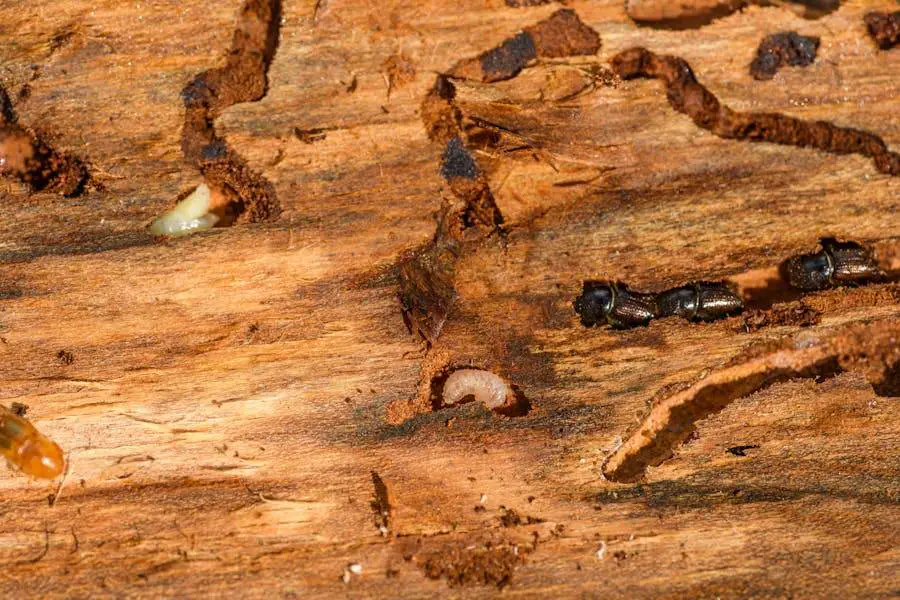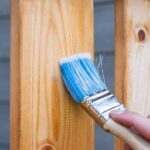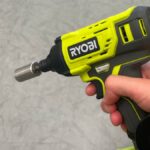Table of Contents
Wood boring insects can be a homeowner’s nightmare, causing extensive damage to furniture, structural timbers, and other wooden elements in the home.

Traditional chemical treatments, while effective, often come with environmental and health concerns.
For those seeking a more eco-friendly approach, various home remedies offer a promising solution.
This article explores effective natural methods to combat wood boring insects, providing detailed insights into each.
Borax Solution
Preparation and Application
A simple yet effective remedy involves the use of Borax (sodium borate), a common laundry additive known for its pest-control properties.
To create this solution, dissolve 1/4 cup of Borax in one gallon of warm water. The key is to ensure the Borax is fully dissolved to create a uniform solution.
This mixture can then be applied directly to affected wood surfaces using a brush or spray bottle, ensuring deep penetration into holes and crevices where larvae might reside.
For untreated or raw wood, multiple applications may be necessary to ensure the solution reaches deeply into the wood’s pores.
Safety Measures and Efficacy
While Borax is less toxic compared to many commercial pesticides, it’s important to handle it with care. Use gloves during application and ensure the room is well-ventilated.
The efficacy of the Borax solution stems from its ability to disrupt the digestive system of wood boring insects.
Once ingested or contacted, it proves fatal to the larvae, preventing further infestation and damage.
Essential Oils
Types and Benefits
Essential oils, particularly eucalyptus and peppermint, are celebrated not just for their pleasant aroma but also for their insect-repelling properties.
These oils contain compounds that are naturally unappealing to wood boring insects, making them effective deterrents.
Their strong scents mask the odors that attract pests to the wood, thus providing a layer of protection.
Application Techniques
To leverage these benefits, mix a few drops of either oil with water in a spray bottle. Spraying this solution onto susceptible wood surfaces can create a repellent barrier.
Because the scent fades over time, regular application—in intervals of a few weeks—is recommended for long-term protection.
This method is particularly suitable for preventive measures and treating lightly infested areas.

Vinegar and Oil Mixture
Creating the Mixture
Vinegar, with its high acidity, acts as a natural repellent for many pests, including wood boring insects.
When mixed with a small amount of vegetable oil, the solution not only repels insects but also provides a protective coating for the wood.
To prepare, mix one part vinegar with a tenth part of vegetable oil, creating a blend that can be applied directly onto the wood.
Application Advice
Using a clean cloth or a brush, apply the mixture generously to the wood, focusing on the affected areas and any visible entry points.
The vinegar deters new infestations, while the oil helps preserve the wood’s finish and prevents drying.
This method works well for furniture and decorative items, offering a dual action of protection and conditioning.
Diatomaceous Earth
How It Works
Diatomaceous earth is a powdery substance made from the fossilized remains of diatoms. It acts mechanically, not chemically, to kill insects.
The sharp edges of the particles pierce the exoskeletons of the wood boring insects, leading to dehydration and death.
This method is effective against a variety of pests and is completely non-toxic to humans and pets.
Method of Application
For effective use, sprinkle diatomaceous earth generously around the affected areas or directly into the entry holes.
Ensure that the powder is distributed evenly and reaches deep into cracks and crevices. For ongoing protection, reapply after cleaning the area or if the powder gets wet.
Heat Treatment
Principle and Precaution
Exposing wood to high temperatures is a proven method to eliminate wood boring insects and their larvae.
The heat disrupts their cellular structure, effectively killing them. However, this method requires careful execution to avoid damaging the wood.
Temperatures should be maintained between 120°F to 140°F for at least six hours to ensure efficacy.
Execution
Using heat lamps or a heat gun, direct the heat evenly across the infected wood surfaces. Monitoring the temperature closely with a thermometer is crucial to prevent overheating.
This method is best suited for small furniture items or detachable wooden parts that can be isolated and treated separately.
Freezing
Concept and Conditions
Similarly, extreme cold can kill wood boring insects by causing their bodily fluids to freeze, leading to cell rupture.
Small wooden items can be wrapped in plastic and placed in a freezer set to 0°F or lower for at least 72 hours.
This method is particularly useful for valuable antiques or delicate items that cannot withstand chemical treatments.
Procedure and Considerations
Ensure the item is well-wrapped to prevent moisture damage. After the freezing period, allow the item to gradually return to room temperature to avoid condensation, which could potentially harm the wood.
Repeat the process if necessary to ensure all larvae and eggs are eradicated.
Physical Removal
Technique and Tools
In cases of localized infestation, physically removing the affected wood can be the most direct method of control.
Using tools like chisels or drills, excise the damaged wood, being careful to remove all traces of the larvae and eggs. This method is invasive and requires subsequent repair and restoration of the wood.
Sealing and Repair
After removal, it’s essential to treat the exposed wood with a protective sealant to prevent future infestations. Fill any cavities with wood filler, sand smooth, and apply a finish matching the original surface.
This restores the wood’s appearance while sealing off any entry points for pests.
Citrus Peel Extract

Citrus peel extract, particularly from lemons and oranges, contains d-Limonene, a compound known for its insecticidal properties.
This natural extract offers a pleasant-smelling, chemical-free option for controlling wood boring insects.
Preparation and Use
Create your own citrus peel extract by soaking citrus peels in vinegar or alcohol for several weeks, then straining the liquid.
This concentrate can be diluted with water and sprayed directly onto the wood surface or used to fill existing holes where larvae may reside.
For enhanced penetration, apply the solution on warm, dry days when the wood can absorb the liquid more efficiently.
Powdered Mustard
Powdered mustard is another unconventional yet effective remedy for treating wood boring insects. Its pungent odor and the natural chemicals within the mustard are unappealing to these pests.
Application Technique
To leverage powdered mustard against wood borers, create a paste by mixing the powder with water. The consistency should be thick enough to adhere to vertical surfaces without running.
Apply this paste liberally to infested areas, covering entry holes and tunnels visible on the wood surface. After 24 hours, brush off the dried mustard and clean the surface with a damp cloth.
How It Works
The application creates an inhospitable environment for the insects, deterring them from remaining in or returning to the treated areas.
Although more research is needed to fully understand the mechanism, anecdotal evidence suggests that the strong smell and potentially irritating compounds within the mustard discourage insect activity, making it a useful tool in the fight against wood boring pests.
Conclusion
Tackling wood boring insects doesn’t have to involve harsh chemicals or professional exterminators.
The home remedies described offer effective, natural alternatives for protecting your wooden treasures.
Regular inspection, early intervention, and consistent application of these methods can keep your wood safe from damage, preserving its beauty and structural integrity for years to come.








